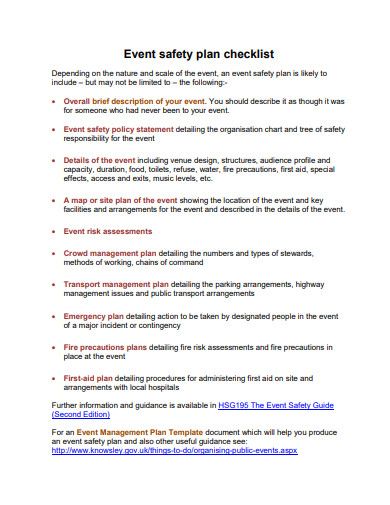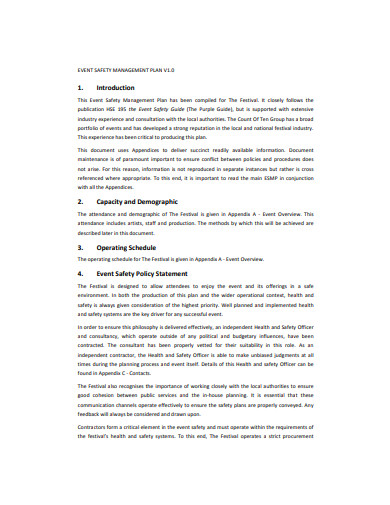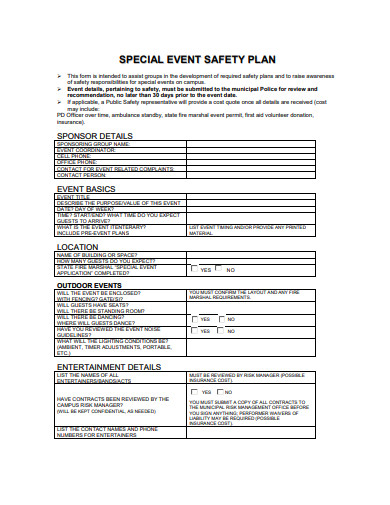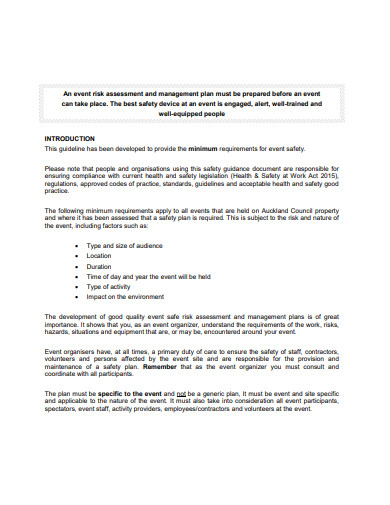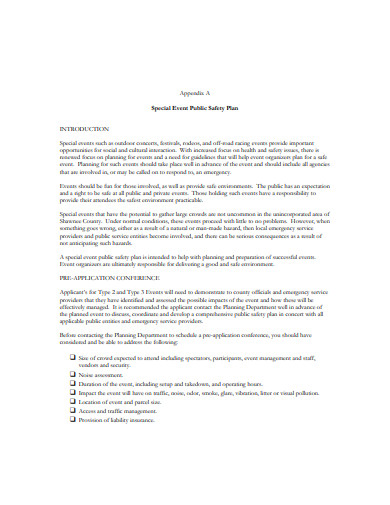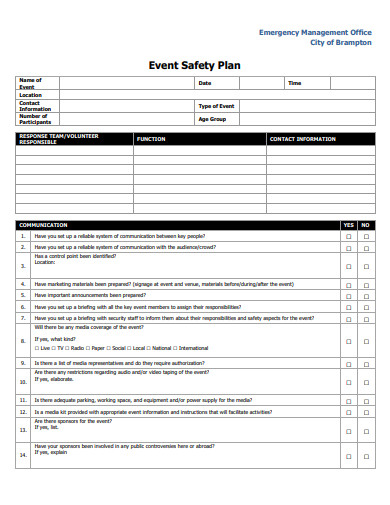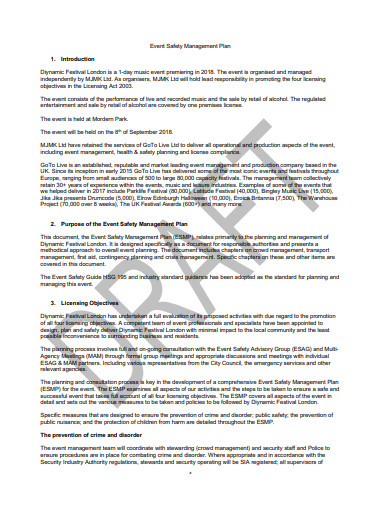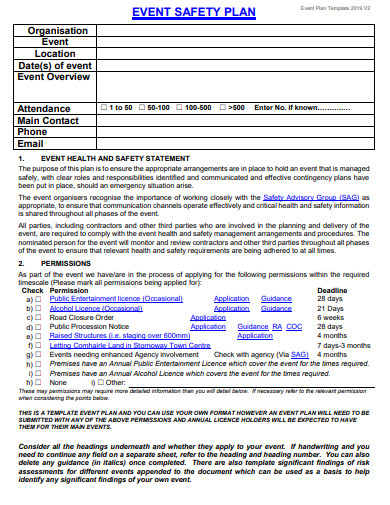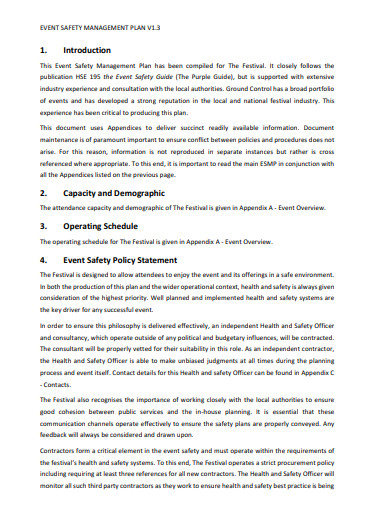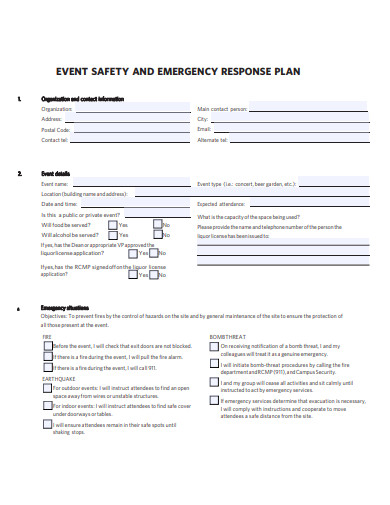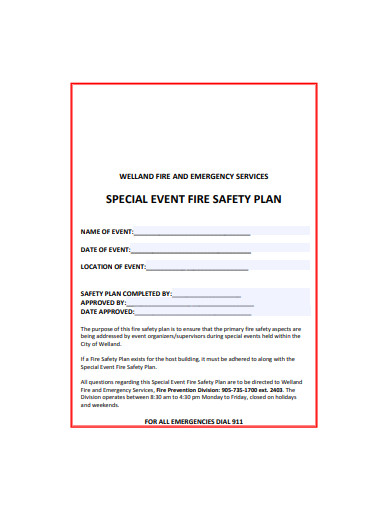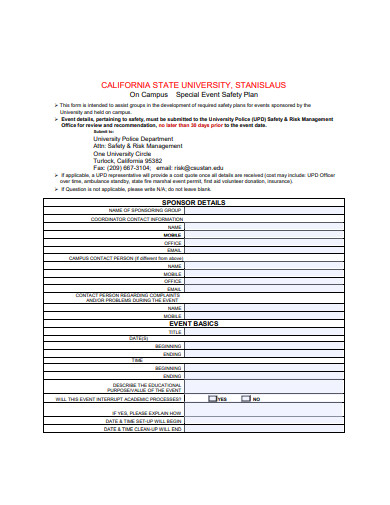11+ Event Safety Plan Examples to Download
Are you planning to organize an event soon? You made the right decision coming here. As an event manager, it is your responsibility to ensure the safety of the participants. These days, violent people take advantage of significant events to terrorize. A heartbreaking news story shocked everyone last May 22, 2017. According to BBC News, a terrorist bombed the Manchester Arena moments after a world-renowned singer performed her final song. This claimed the lives of 22 people. While the gathering you’re planning might not be as complex as that, the point still stands. A lot of dangerous situations could take place during an occasion. If accidents would take place in your event, then people might acquire injuries or—in worst-case scenarios, even die. Don’t put the safety of the people at risk. Devise an event safety plan.
What Is an Event Safety Plan?
Organizing an event requires a lot of planning regarding the program, food, venue, activities, and, most importantly, the budget. You might already be very preoccupied with this, but you need to spare time to plan the safety of the event. An event safety plan is a plan that documents the risks and the hazards that might take place in an event. Aside from that, this plan would also provide ways on how to eliminate these hazards and reduce the risks.
11+ Event Safety Plan Examples
1. Event Safety Plan Checklist
2. Event Safety Management Plan
3. Special Event Safety Plan
4. Event Safety Risk Assessment and Management Plan
5. Special Event Public Safety Plan
6. Event Safety Plan Format
7. Sample Event Safety Management Plan
8. Event Safety Plan Format
9. Basic Event Safety Management Plan
10. Event Safety and Emergency Response Plan
11. Special Event Fire Safety Plan
12. Special Event Safety Plan Format
How to Effectively Plan for Your Event’s Safety
It would be very irresponsible to rush making a safety plan, knowing that the people’s safety depends on that. Devising this plan would require extensive attention to detail. One careless mistake could cost you a lot of lives. To create an event plan that would guarantee the safety of everyone in your event, follow these steps:
1. Assess Possible Hazards and Risks
The thoroughness and duration of the assessment would depend on the size of the event. If the event you’re planning isn’t that big, a standard risk assessment will do. Risk assessments include addressing particular issues that could compromise the people’s safety and determining ways to eliminate these hazards. If it’s a big event, it is advisable to get help and hire a safety adviser or analyst who can take into account all of the possible dangers that could occur.
2. Consider Staffing Security Personnels
The lack of security personnel causes most mishaps during events. Before hiring them, make sure that they are experienced and qualified. If anything happens, they would be the first people to respond. Moreover, they should be highly-trained, skilled, and knowledgeable enough when it comes to handling difficult and dangerous situations. Having security services would also discourage reckless behavior and make people feel secured. Also, consider having an ambulance and fire services on standby.
3. Ensure Adequate Lighting
The lighting sets the mood. You can get creative when it comes to the lighting of your event, as long as it provides proper visibility to the participants. If your lighting is too dark, people wouldn’t be able to see clearly, which could result in accidents. We don’t know what dangers the dark could hold. If it’s dark, there’s a lesser chance for the security personnel to see what people are doing. People with bad intentions could easily take advantage of this situation. For your event plan to be safer, ensure well-lit signed exits, hallways, and facilities. Emergency lighting should also be on standby in case something happens.
4. Crowd Management
A large crowd of people compromises their safety. If your event involves hundreds or thousands of people, your plan should include a means on how to control and manage them. People act differently when they’re on a crowd, so it’s harder to control them. With that said, it is important to come up with a strict yet effective and functional crowd management plan.
5. Conduct Training and Briefing
Emergencies can take place anytime and anywhere. It is possible to experience one during your event. Prior to the event, let all the staff undergo training and briefing on how to respond to emergencies. They should also be briefed about where the fire safety exits are located in the venue. Everyone should be aware of their role and all the risks they are exposed to during the event.
What should I include in a safety plan?
Your event safety plan can be specific for a particular activity or hazard. It can also be comprehensive—for instance, an injury or illness prevention program. Either way, it should meet the requirements. The Occupational Safety and Health Administration is the agency that aims to protect workers. They recommended essential elements that each safety plan should include. These elements are the list of responsible staff, hazard identification, safety policies, emergency response, goals statement, training, and recordkeeping.
What is event risk management?
Every action you make could make you vulnerable to risks. This is why risk management is a crucial part of an event management plan. Risk management is recognizing potential risks and hazards and reducing or eliminating them. It covers many areas, including the beverage and food management, logistics, transportation, financing, the attendees, and more.
What are the elements of safety culture?
To maintain a safety culture, you must consider these elements. The first one is responsibility. Every individual should act responsibly inside and outside of the organization. Next is accountability. Managers or superiors in the company should be held accountable to act as a role model for everyone. The third element is ethics. Both the management system and the employees should be ethically driven. Everyone in your company must be able to make ethical and rational decisions, given any situation. Communication is the fourth and last element. The employer and the leaders inside the company must listen to the concerns of the employees. Both parties should be able to communicate their expectations of each other. They should engage in communication that flows both ways. If you give these elements enough importance, then there’s a great possibility that you can maintain a safety culture within an organization.
Events should be remembered for its noteworthiness and not for the chaos it brings. It is a difficult task to prepare for the unknown, but it’s always better to prepare ahead. Get your event and the participants out of harm’s way with a reliable event safety plan. Your safety plan will serve as the primary protection for everyone in the event. Make sure to tick off every single thing on your safety checklist. Although safety isn’t the only thing that can influence the success of your event, it is for sure, the most important thing to consider.



